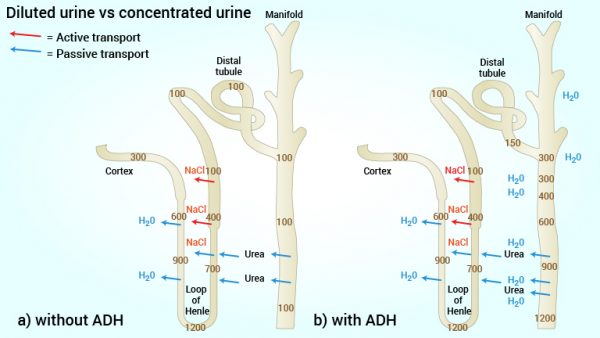In addition to the reabsorption of various substances from the filtrate, the kidneys also secrete different substances from the blood into the nephrons.
As described above, one of the functions of the hormone aldosterone is to increase the secretion of potassium. In addition, ammonium (nitrogen waste), various acids and creatinine (nitrogen waste) and a variety of other biochemical products and especially drugs are also secreted into the tubules.
Through tubular secretion the kidneys control and regulate the renal elimination of waste, potassium and control the blood pH (see section below).
Dilute vs. concentrated urine
The kidneys are able to control the concentration of urine according to the body’s needs thus creating dilute or concentrated urine.
When you are sipping a bottle of water steadily throughout the day, you will have a recurrent need to urinate. And every time you do, you will see that your urine is clear and light in colour. At other times, if you do not drink over several hours, the colour of the urine is significantly darker and may havean odour.
In the first case, you have a dilute urine – a urine containing little salt and waste in relation to water quantity. In the latter case, the body needs to conserve water because you are continually losing water through the skin and breath, the kidneys are working to reabsorb most of the water in the filtrate. therefore producing a concentrated urine – a urine with many solutes, with the least possible water.
When referring to the terms dilute and concentrated in a physiological context, we are referring to their concentration relative to the concentration of blood plasma.
The starting point to create thin or concentrated urine is described above under tubular reabsorption. When the filtrate arrives at the distal tubules, most of the water and salts are already reabsorbed and the filtrate is already more dilute. than when first filtered.
However, if circumstances require the kidneys to make a concentrated urine, that is, that the body is in a state where the fluid levelsare relatively low and salt concentration is relatively high, the pituitary gland secretes anti-diuretic hormone (ADH) which acts on the collecting ducts of the nephrons and increases the uptake of water. Increased water absorption means that the filtrate becomes more and more concentrated as long as it runs through the collecting ducts on the way to the medulla (Fig. 10). Accordingly, the kidneys produce a concentrated urine. ADH is secreted from the pituitary gland only when the salt concentration in the blood is high (exceeds a physiological concentration).
In this way, ADH, regulates the concentration of urine producing either dilute or concentrated urine depending on the water and salt balance in the body.

Fig.15 Thin vs. concentrated urine: This figure illustrates how the antidiuretic hormone (ADH) affects urine concentration. The numbers in the figure represent the total concentration of all solutes in pre-urine (expressed in milliosmoles). Physiological fluids have a concentration of 300 milliosmoles, and the figure shows that the pre-urine arriving at the Loop of Henle has the same concentration as plasma. At the distal tubule, urine present is more diluted relative to plasma (100 milliosmoles). If ADH is not present at the collection tubes (manifold) (a) the pre-urine remains at the same concentration as in the distal tubule, and kidneys produce therefore a weak urine. If ADH is present at the collection tubes (b) water in the collection tubes (manifold) is absorbed and transferred to the surrounding capillaries, and so concentration of pre-urinen increases. This water absorption occurs due to the fact that the collection tubes (manifold) lead the pre-urine down into the renal medulla, where the salt concentration in interstitial fluid increases (more so deeper in the medulla). Since ADH increases the manifolds permeability to water, water gets pressed out of the collecting pipes (manifold) due to an increased osmotic pressure in the medulla. In this case, the kidneys produce concentrated urine.



